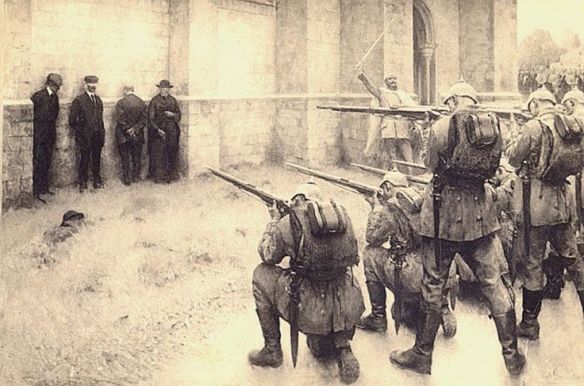Depiction of the execution of civilians in Blégny by Évariste Carpentier
The German Army has often been admired for its military professionalism, its efficiency, and its discipline, all of which contributed to astonishing victories against numerically far superior opponents. This assessment is certainly not untrue, but it neglects the other side of the coin: a military culture which favored a broad interpretation of the term “military necessity” and that paved the way for an extreme use of violence. In particular, most forms of civilian resistance were countered with drastic measures, including shooting hostages and burning down houses. To put such actions in historical context, it is important to note that the laws of armed conflict were vague at this time, and allowed considerable freedom of interpretation.
In the early days of World War One, the invading German Army spread violence among the civilian populations in Belgium and northern France. With the memory of the so-called Francs-Tireurs (“Free- Shooters”) of the Franco-Prussian War (1870-71) still fresh, German soldiers overreacted against mostly imagined ambushes and took drastic countermeasures: up to 6,000 Belgian and French civilians are believed to have been killed in these first few weeks of the war. However, these events were short-lived; they stopped as soon as the front line stabilized in early fall 1914.
It was only in 1918 that the German Army was confronted with a large-scale partisan war in the occupied Ukraine. In this largely forgotten chapter of history, the Germans faced a Bolshevik insurgency supported by small landowners. The initial German response to this threat was fairly similar to the tragic days of summer 1914 on the Western Front: harsh orders were issued to shoot all captured “bandits,” burn down houses, impose contributions on villages, and seize hostages. At the first stage, the Germans tried to put down this Moscow-sponsored Bolshevik revolution by sheer force alone. However, soon understanding that these methods lacked a long-term perspective, they started developing a more sophisticated approach. The German authorities built up an effective network of agents in the communities and a locally recruited self-defense force. The drastic early orders were now replaced by moderate tones in an attempt to build a feeling of trust among the population. German troops were instructed to cooperate closely with the Ukrainian administration in order to identify real partisans and supporters; fatal mistakes could therefore be avoided. On the political level, the Germans tried to stabilize the de jure independent Ukrainian government by fostering close economic bonds between the two states. However, neither the first socialist government, nor its nationalist-authoritarian successor from May 1918, ever found much acceptance among the Ukrainian population.
Despite this lack of political support, the Germans were able to suppress the Bolshevik insurgency by early summer 1918, and a time of relative calm reigned in the Ukraine until the withdrawal of German troops in November 1918. The Ukraine in 1918 is thus one of the rare examples of a successful counterinsurgency campaign in modern history. However, it must remain uncertain if this achievement would have been of lasting duration in a long-term German occupation. Nonetheless, it is noteworthy that the Germans were able to stabilize the country, despite impending defeat on all other fronts of the war. And it is also indisputable that they took the right path towards a relatively modern counterinsurgency strategy.
In the interwar years, the German militaries forgot all the positive lessons learned in the Ukraine in 1918. In the 1920s the Reichswehr, having been cut down to 100,000 men by the Treaty of Versailles, planned a conventional defensive war; in the 1930s the Wehrmacht experimented with armored mobile warfare. The image of a more or less clear-cut front-line war between two mass armies dominated German military thinking. Aside from short-lived ideas in the mid-1920s about a people’s war on home territory, irregular warfare played no role in the German concept of a future war.
However, the mentality of the officers’ corps underwent a drastic radicalization in the aftermath of World War One. When revolution broke out in Germany in November 1918, monarchy was swept away, and the democratic government immediately concluded a ceasefire. For most officers, more than four years of fighting and dying on the Front seemed to have been in vain. In their perception, this shame was due to socialist agitation on the home front; the German Army had remained undefeated in the field and was “stabbed in the back.” Besides, Communist insurgencies at home, Polish usurpations in Upper Silesia, and the Bolshevik advance in the Baltic States all challenged the stability of Germany. Irregular warfare played a vital role in these conflicts, and all were fought with extreme brutality on both sides. Many German officers of the so-called Freikorps (“Freecorps”) suspected that socialists and Jews were behind all these upheavals. The traditional fear of Francs-Tireurs had been enriched with a new ideological element, and the fervor of the struggles further enhanced this paranoia. All these elements were grim predictors of the coming devastations of World War Two.
